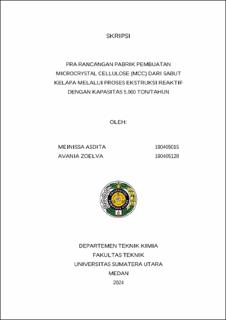Pra Rancangan Pabrik Pembuatan Microcrystal Cellulose (MCC) dari Sabut Kelapa melalui Proses Ekstruksi Reaktif dengan Kapasitas 5.000 Ton/Tahun
Preliminary Design of a Plant for Microcrystal Cellulose (MCC) Production from Coconut Husks via Reactive Extrusion Process with a Capacity of 5,000 Tons/Year

Date
2024Author
Asdita, Meinissa
Zoelva, Avania
Advisor(s)
Halimatuddahliana
Metadata
Show full item recordAbstract
Microcrystal Cellulose (MCC) is isolated from alpha cellulose, which is pure cellulosa-producing porous particle powder and has properties that are insoluble in water but can float when exposed to water. MCC is a material that can be used in the pharmaceutical industry, namely as a filler, in the food industry as a fat source material, in the plastic industry as a composite manufacturing material, and can also be applied in the cosmetic industry.
In the pre-planning of this plant, MCC is made from raw materials that have a high cellulose content and are widely available in Indonesia. One of the raw materials that can be used is coconut husks with a cellulose content of 43.44%. The MCC plant is planned to produce 5,000 tons per year and operate for 330 days in a year.
In the preliminary design of this MCC plant, we will use a reactive extraction process. Reactive extraction is the process of combining friction, pressure, and heat. The tool that will be used in this selective extraction process is an extruder with a single screw extrude type. The extruder will rotate, which can generate pressure and temperature. By applying pressure to the extruder, it will create strong friction and produce a shorter reaction time. The main process in the MCC plant pre-design consists of two main processes and one bleaching process, namely:
1. The process of delignification of lignin into na-lignate
2. Process of hydrolysis of cellulose into MCC
3. The process of bleaching using H2O2
The design of the main process tool is based on the pre-project MCC factory manufacturing with coconut rope raw materials through a reactive extraction process, those are:
1. Delignification.Reactions
• Catalytic used : NaOH 17.5%
• Temperature : 90°C
• Pressure : 1 atm
• Time : 1 hour
2. Hydrolysis reactions
• Catalytic used : HCl 5%
• Temperature : 140 °C
• Pressure : 1 Atm
This plant is planned to be established in Indragiri Hilir district, Riau Province, with an area of 15,756 m2. The workforce needed as many as 200 people with a limited company (PT) under the leadership of a chief executive officer.
The results of the economic evaluation of the MCC Manufacturing Factory for this coconut strap are as follows:
a. Capital Investment (CI) = Rp 535.260.154.908
b. Total Cost (TC) = Rp 234.639.377.945
c. Profit Margin (PM) = 50,42%
d. Break Even Point (BEP) = 44,55%
e. Return on Investment (ROI) = 30,67%
f. Return On Network (RON) = 51,12%
g. Pay Out Time (POT) = 3 tahun 2 bulan
h. Internal Rate of Return (IRR) = 56,00%
From the results of the economic evaluation, it can be concluded that the manufacturing factory for microcrystal cellulose is worthy of being established.
Collections
- Undergraduate Theses [1239]
